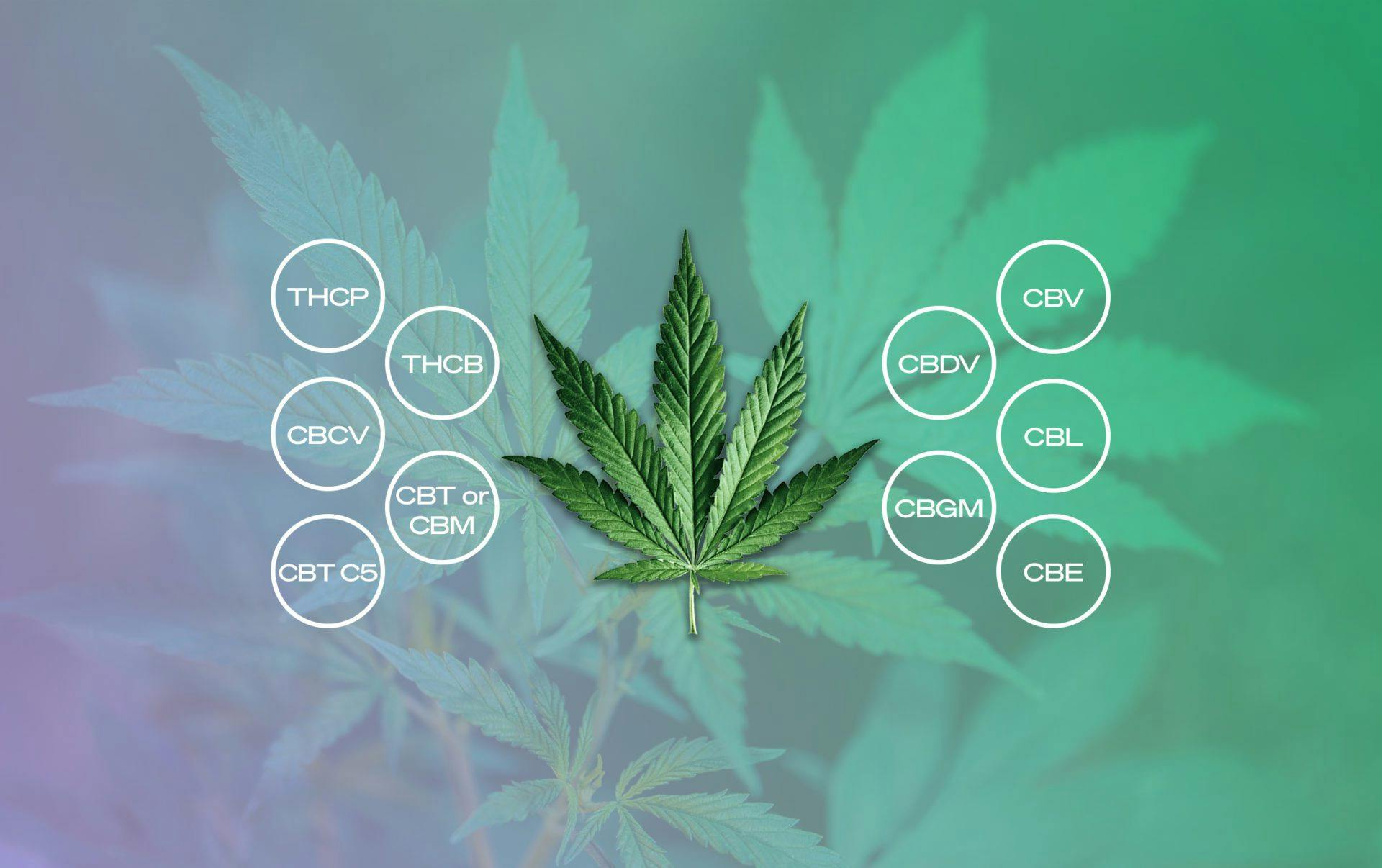14 Minor Cannabinoids to Have on Your Radar

Article written by

Tina MagrabiSenior Content Writer
Content reviewed by

Dr. Lewis JasseyMedical Director - Pediatric Medicine
You might know that THC makes you high and that CBD can ease anxiety. But did you know that there are more than a dozen other naturally occurring cannabinoids in the cannabis plant? THC and CBD are the major cannabinoids, but the minor cannabinoids play a pivotal role in healing the body and stimulating the mind.
Here, we take an in-depth peek into 14 minor cannabinoids that occur in lower concentrations than THC and CBD in the cannabis plant. The cannabinoids we’re looking at are:
- Cannabichromene (CBC)
- Tetrahydrocannabivarin (THCV)
- Cannabigerol (CBG)
- Cannabinol (CBN)
- Tetrahydrocannabiphorol (THCP)
- Tetrahydrocannabutol (THCB)
- Cannabidivarin (CBDV)
- Cannabielsoin (CBE)
- Cannabicyclol (CBL)
- Cannabichromevarin (CBCV)
- Cannabivarin (CBV)
- Cannabicitran (CRM, CBT or CBM)
- Cannabitriol (CBT C5)
- Cannabigerol Monomethyl Ether (CBGM)
Many of these cannabinoids remain cloaked in mystery to scientists. The further we proceed down the list, the less is currently understood about how these cannabinoids function in the human body.
Get your medical marijuana card
Connect with a licensed physician online in minutes.
Cannabichromene (CBC)
How It Works in the Body
Cannabichromene (CBC) is the third most prominent cannabinoid in the cannabis plant, behind CBD and THC. CBC is a potent anti-inflammatory and could be more beneficial than CBD as an antidepressant. In contrast, CBC does not produce a euphoric high like THC and is a non-psychoactive cannabinoid. However, CBC binds with specific cannabinoid receptors in the human body, including receptors linked to pain perception.
Benefits
CBC may be up to 10 times more potent than CBD for treating stress and anxiety and has significant anti-inflammatory, pain-reducing, antiviral, anti-tumor, and bone-growth-stimulating properties.
Strains High in CBC
- Maui Dream
- Blue Cherry Soda
- Charlotte’s Web
Download Free Guide to CBC
Tetrahydrocannabivarin (THCV)
How It Works in the Body
Tetrahydrocannabivarin (THCV) has both non-psychoactive and psychoactive effects, depending on the dosage. Low doses of THCV have an anti-psychoactive effect; larger doses have a psychoactive effect.
Benefits
THCV may be useful for reducing appetite and managing weight. This minor cannabinoid appears to positively affect insulin resistance, making it a valuable tool in preventing or treating diabetes. Finally, this cannabinoid has demonstrated anti-inflammatory properties in animal studies.
Strains High in THCV
- Girl Scout Cookies
- Pineapple Purps
- Dutch Treat
Download Free Guide to THCV
Cannabigerol (CBG)
How It Works in the Body
Cannabigerol (CBG) is a non-intoxicating cannabinoid that may exert psychoactive effects. CBG can boost anandamide (the bliss chemical) without psychoactive effects, and it could be a mellower alternative or addition to THC.
Benefits
Science has shown that CBG has therapeutic potential for chronic pain, neurogenetic disorders, multiple sclerosis, irritable bowel disease (IBD), Huntington’s disease, and glaucoma.
Strains High in CBG
- Jack Frost CBG
- Matterhorn CBG
- Lemon Cream Diesel CBG
Cannabinol (CBN)
How It Works in the Body
Dubbed the sleepy cannabinoid, cannabinol (CBN) has sedative effects and may help people with insomnia. CBN is also an appetite stimulant with potent antibacterial properties.
Benefits
CBN may be useful for treating respiratory distress related to asthma and allergies. Furthermore, studies have shown CBN to help manage autoimmune conditions like Crohn’s disease.
Strains High in CBN
- Bubble Gum
- Purple Cadillac
- Super Green Crack
Tetrahydrocannabiphorol (THCP)
Benefits
THCP has shown promise in decreasing nausea and pain, making it a potential therapeutic complement for people with cancer.
Strains High in THCP
- FM2
Tetrahydrocannabutol (THCB)
A group of Italian scientists discovered tetrahydrocannabutol and two other new cannabinoids in 2020. THCB is a very new cannabinoid discovery and is not well understood yet.
Cannabidivarin (CBDV)
How It Works in the Body
CBDV is considered a non-psychoactive cannabinoid that is found mainly in indica strains.
Benefits
Like CBD, which is the basis for the epilepsy medication Epidiolex, CBDV may also reduce seizure frequency and severity. Treating nausea and inflammation are two other promising benefits of this minor cannabinoid.
Strains High in CBDV
- Forbidden V (or Forbidden Fruit)
- Pine Walker
- Painkiller XL
Cannabielsoin (CBE)
CBE is derived from CBD and may offer many of the same benefits. The cannabinoid works with CBD, other cannabinoids, and flavonoids to activate the entourage effect.
Cannabicyclol (CBL)
CBL is found in extremely low levels in cannabis and is poorly understood. Most cannabis strains contain only trace amounts of CBL, if any. One study conducted in New Zealand found that CBL caused convulsions in rabbits, and it is unclear whether it could have the same troubling effect on humans.
Cannabichromevarin (CBCV)
CBCV has similar properties to CBC and may treat insomnia, epilepsy, amyotrophic lateral sclerosis (ALS), and a spectrum of other conditions.
Cannabivarin (CBV)
CBV is another obscure cannabinoid that scientists have not adequately probed. Benefits may include treating mood disorders and improving sleep, but concrete evidence is lacking.
Cannabicitran (CRM, CBT or CBM)
CBT is found in cannabis strains with high CBD and low THC levels. Like other minor cannabinoids, CBT may help people with glaucoma by reducing intraocular pressure (pressure in the eye).
Cannabitriol (CBT C5)
CBT C5 is a type of CBT found either in low concentrations in cannabis or completely absent. The chemical structure of CBT C5 is similar to that of THC, but this minor cannabinoid’s possible psychoactive effects are presently unclear.
Cannabigerol Monomethyl Ether (CBGM)
Discovered in Japan in 1968, CBGM may have anti-cancer and anti-inflammatory effects. The one known cannabis strain to contain CBGM in measurable quantities is Minamiashihara #1, which led Japanese scientists to discover CBGM in the 1960s.
The Bottom Line on the Minor Cannabinoids
Even though many minor cannabinoids are often grouped with the big six cannabinoids, small changes in a cannabinoid’s structure can cause vastly different physiological effects. They are also usually present in much smaller amounts than other cannabinoids. They often come as a package with them, making it even more challenging to separate them and understand their effects on the human body.
However, there is much interest in these smaller cannabinoid groups for their unique effects (when they have them in the first instance). Expect to see a more significant number of varieties with richer concentrations of these minor cannabinoids in the future.
Apply for a medical marijuana card to experience the potential benefits of the major and minor cannabinoids.
Get Your Medical Card
Connect with a licensed physician online in minutes.



